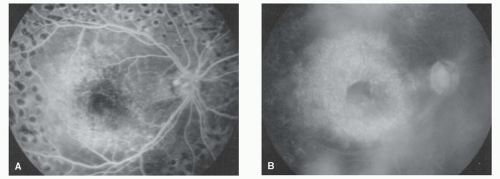Laser Treatment for Diabetic Retinopathy (Clinically Significant and Diffuse Macular Edema: Fundamentals of the Early Treatment Diabetic Retinopathy Study)
Yukihiro Sato
Macular edema is the most common cause of vision loss in patients with diabetic retinopathy. There are several reports of randomized clinical trials of photocoagulation for diabetic macular edema (1, 2, 3, 4, 5 and 6). Among these trials, the Early Treatment Diabetic Retinopathy Study (ETDRS) (5,6) included by far the largest number of patients. The ETDRS was designed to address three major questions in the management of patients with nonproliferative or early proliferative diabetic retinopathy:
When in the course of diabetic retinopathy is it most effective to initiate panretinal photocoagulation?
Is photocoagulation effective in the treatment of diabetic macular edema?
Is aspirin treatment effective in altering the course of diabetic retinopathy?
Because the purpose of this chapter is to clarify the efficacy of macular surgery in diabetic retinopathy, only the answer to the second question is summarized and discussed.
Data from the ETDRS shows that focal photocoagulation for “clinically significant” macular edema (CSME) in diabetic retinopathy substantially reduces the risk of moderate visual loss. Focal treatment also increased the chance of visual improvement, decreases the frequency of persistent macular edema, and causes only minor visual-field losses. The beneficial effects of treatment demonstrated in this trial suggested that all eyes with CSME should be considered for focal photocoagulation, even if visual acuity is not yet reduced. CSME includes not only focal but also diffuse macular edema (5,6). However, the beneficial effects of focal photocoagulation for diffuse macular edema are not clear, given that these eyes respond poorly to treatment as compared to eyes with focal macular edema (3).
CLASSIFICATION OF DIABETIC MACULAR EDEMA
Bresnick (7,8) classified diabetic macular edema into focal macular edema and diffuse macular edema (Table 21-1). Focal macular edema is characterized by focal leakage mainly from microaneurysms but occasionally from dilated capillaries. This leakage can be demonstrated clearly by intravenous fluorescein angiography. Often there is associated accumulation of extravascular lipoprotein exudate deposition in a circinate pattern (Fig. 21-1). In contrast, diffuse macular edema is characterized by diffuse leakage from retinal vessels in and around the macular area, often accompanied by cystoid macular changes (Fig. 21-2). Bresnick (7) stated that diffuse macular edema may result from not only a breakdown of the inner blood-retinal barrier (e.g., microaneurysms, retinal capillaries, and even arterioles) but also a breakdown of the outer blood-retinal barrier (i.e., retinal pigment epithelium).
TABLE 21-1 CLASSIFICATION OF DIABETIC MACULAR EDEMA | ||
|---|---|---|
|
DEFINITION OF CLINICALLY SIGNIFICANT MACULAR EDEMA
The ETDRS (5) defined CSME as the presence of one or more of the following criteria:
Thickening of the retina at or within 500 mm of the center of the macula (Fig. 21-3A,B).
Hard exudates at or within 500 mm of the center of the macula, if associated with thickening of adjacent retina (not residual hard exudates remaining after disappearance of retinal thickening) (Fig. 21-3C).
A zone or zones of retinal thickening one disc area or larger, any part of which is within one disc diameter of the center of the macula (Fig. 21-3D).
STUDY DESIGN AND TREATMENT METHODS OF THE EARLY TREATMENT DIABETIC RETINOPATHY STUDY
The ETDRS had a somewhat complex randomization scheme (Figs. 21-4, 21-5 and 21-6). First, eyes with macular edema were subdivided into two groups: eyes with less severe retinopathy (mild-to-moderate nonproliferative retinopathy), and eyes with more severe retinopathy (severe nonproliferative or early proliferative retinopathy). Then each subgroup was further randomly assigned to “early (immediate) photocoagulation” or “deferral of photocoagulation” until high-risk proliferative retinopathy developed. High-risk proliferative retinopathy has been previously defined by the Diabetic Retinopathy Study (9) as retinopathy with moderate or severe optic nerve neovascularization or any neovascularization with hemorrhage.
For focal treatment of macular edema, a pretreatment fluorescein angiogram was used during photocoagulation to identify “treatable lesions” (Table 21-2). Treatment was prescribed for all such lesions located within two disc diameters of the center of the macula. Treatment of lesions closer than 500 mm to the macula was not required initially. If vision was less than 20/40, however, and the retinal edema and leakage persisted, treatment of lesions up to 300 mm from the center was recommended. For focal macular edema, microaneurysms and other focal leakage sites received photocoagulation. Areas of diffuse leakage were treated in a grid pattern.
Stay updated, free articles. Join our Telegram channel

Full access? Get Clinical Tree





